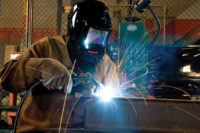Welding fumes
 Synonyms vary depending upon the specific component of the welding fumes.
Synonyms vary depending upon the specific component of the welding fumes.
Physical Description
Fumes generated by the process of joining or cutting pieces of metal by heat, pressure, or both.
Properties vary depending upon the specific component of the welding fumes.
Exposure Routes
Inhalation, skin and/or eye contact
Symptoms
Symptoms vary depending upon the specific component of the welding fumes; metal fume fever: flu-like symptoms, dyspnea (breathing difficulty), cough, muscle pain, fever, chills; interstitial pneumonitis; (potential occupational carcinogen)
Target Organs
Eyes, skin, respiratory system, central nervous system
Cancer Site
lung cancer
Personal Protection/Sanitation
Skin: No recommendation
Eyes: No recommendation
Wash skin: No recommendation
Remove: No recommendation
Change: No recommendation
Eye: Irrigate immediately
Skin: Soap wash
Breathing: Respiratory support
Respirator Recommendations
NIOSH
At concentrations above the NIOSH REL, or where there is no REL, at any detectable concentration:
(APF = 10,000) Any self-contained breathing apparatus that has a full facepiece and is operated in a pressure-demand or other positive-pressure mode
(APF = 10,000) Any supplied-air respirator that has a full facepiece and is operated in a pressure-demand or other positive-pressure mode in combination with an auxiliary self-contained positive-pressure breathing apparatus
Escape:
(APF = 50) Any air-purifying, full-facepiece respirator (gas mask) with a chin-style, front- or back-mounted organic vapor canister having an N100, R100, or P100 filter.
Source: NIOSH
Looking for a reprint of this article?
From high-res PDFs to custom plaques, order your copy today!





